文体学--VarietiesPPT课件
- 格式:ppt
- 大小:401.50 KB
- 文档页数:48
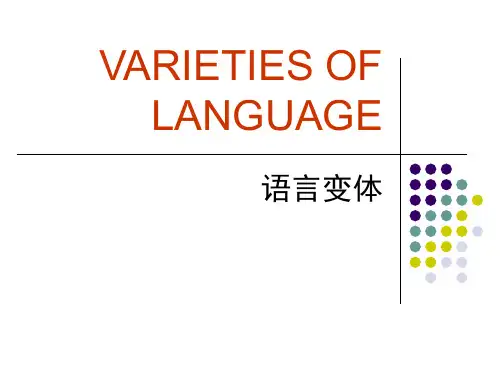
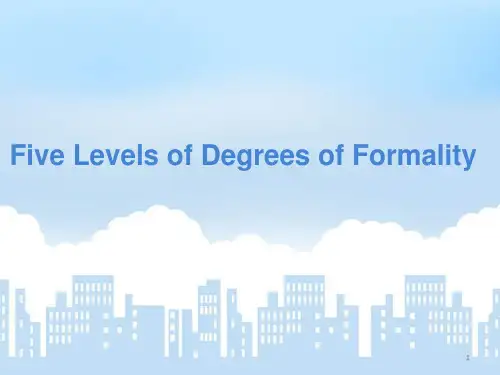
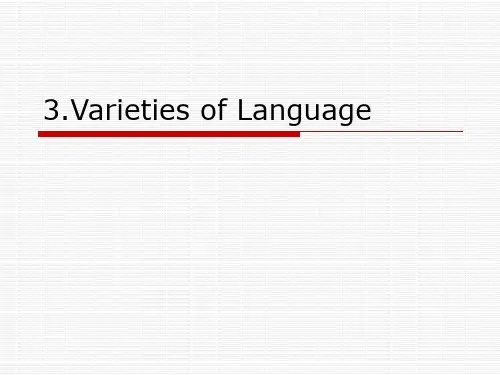
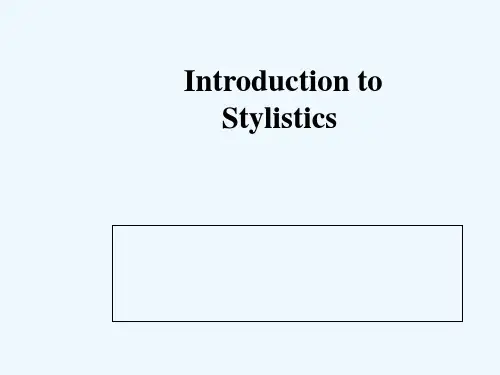
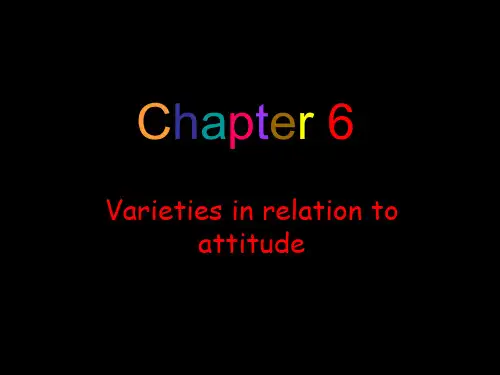
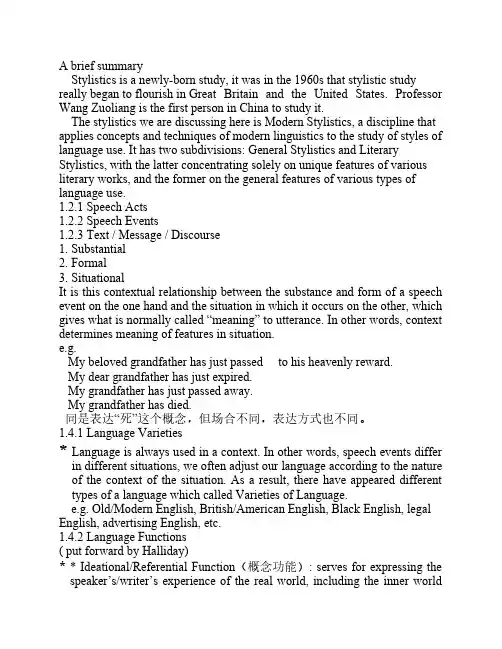
A brief summaryStylistics is a newly-born study, it was in the 1960s that stylistic study really began to flourish in Great Britain and the United States. Professor Wang Zuoliang is the first person in China to study it.The stylistics we are discussing here is Modern Stylistics, a discipline that applies concepts and techniques of modern linguistics to the study of styles of language use. It has two subdivisions: General Stylistics and Literary Stylistics, with the latter concentrating solely on unique features of various literary works, and the former on the general features of various types of language use.1.2.1 Speech Acts1.2.2 Speech Events1.2.3 Text / Message / Discourse1. Substantial2. Formal3. SituationalIt is this contextual relationship between the substance and form of a speech event on the one hand and the situation in which it occurs on the other, which gives what is normally called “meaning” to utterance. In other words, context determines meaning of features in situation.e.g.My beloved grandfather has just passed to his heavenly reward.My dear grandfather has just expired.My grandfather has just passed away.My grandfather has died.同是表达“死”这个概念,但场合不同,表达方式也不同。

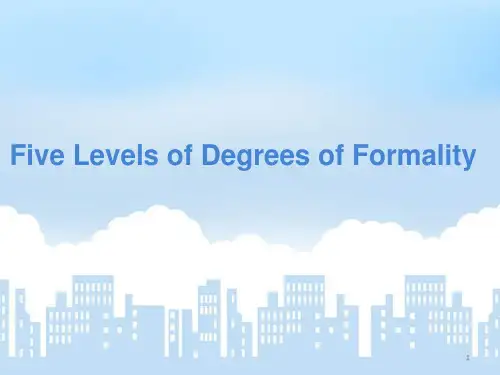

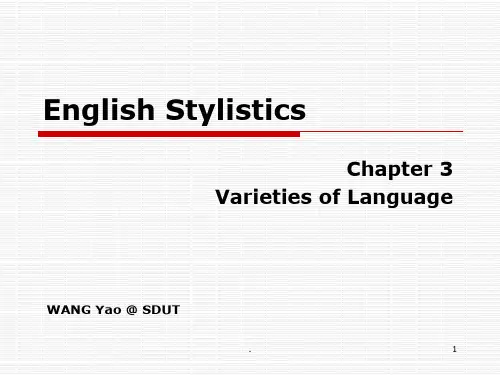
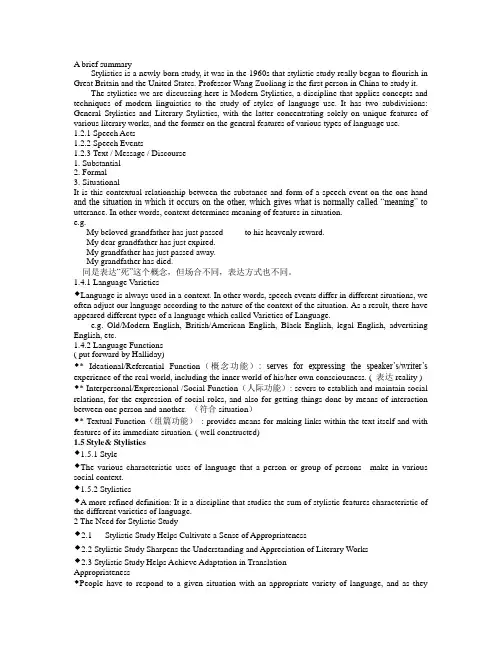
A brief summaryStylistics is a newly-born study, it was in the 1960s that stylistic study really began to flourish in Great Britain and the United States. Professor Wang Zuoliang is the first person in China to study it.The stylistics we are discussing here is Modern Stylistics, a discipline that applies concepts and techniques of modern linguistics to the study of styles of language use. It has two subdivisions: General Stylistics and Literary Stylistics, with the latter concentrating solely on unique features of various literary works, and the former on the general features of various types of language use.1.2.1 Speech Acts1.2.2 Speech Events1.2.3 Text / Message / Discourse1. Substantial2. Formal3. SituationalIt is this contextual relationship between the substance and form of a speech event on the one hand and the situation in which it occurs on the other, which gives what is normally called ―meaning‖ to utterance. In other words, context determines meaning of features in situation.e.g.My beloved grandfather has just passed to his heavenly reward.My dear grandfather has just expired.My grandfather has just passed away.My grandfather has died.同是表达―死‖这个概念,但场合不同,表达方式也不同。
Chapter 3 Varieties of Language语言变体(varieties of language)可分为两类:一类是方言变体(dialectal varieties), 俗称方言;另一类是话语类变体(diatypic varieties), 亦称语域(register)。
方言是以语言的使用者(users)为基准而区分的语言变体;语域则是按照语言使用者对语言的使用(uses)而区分的语言变体。
因此,方言多与交际者的社会阶层、社会地位、地域、年龄、性别及所处的时代等因素有关,比较稳定;语域则多与交际者所从事的社会活动密切相关。
方言(Dialect):1) 语言使用者的个人特征(individuality)--Idiolect(语言的流利度、清晰度、表达能力大小等。
例:Mr X’s English, Mr Y’s English。
)2) 时代特征(temporal features)--Temporal Dialect3) 地域特征(geographical feature)--Regional Dialect4) 社会特征(social features)--Social DialectSocioeconomic status varieties 社会经济变体Ethnic varieties 种族变体Gender varieties 性别变体Age varieties 年龄变体5) 可理解的程度和范围—Standard Dialect方言(Dialects)具有社会指示功能,方言不仅能体现人物的地域特征,而且能反映出人物的社会地位、文化程度乃至个人性格,这一点在文学作品中最为明显语域(Register)1) Field of Discourse(话语范围/语场)Non-technical fields of discourseTechnical fields of discourse2) Mode of Discourse(话语方式/语式)Speech: conversing, monologuingWriting: texts written to be spoken as if not written/ written to be read3) Tenor of Discourse(话语基调/语基)Personal Tenor(个人基调)Functional Tenor(功能基调)1) Field of Discourse(话语范围/语场)话语范围指的是言语交际过程中发生的事情,进行的活动,论及的事情或表达的经验等,它能体现语言使用者在特定情境语境中所要实现的交际目的和作用。
英语文体学3,4Chapter 3 Varieties of Language语言变体(varieties of language)可分为两类:一类是方言变体(dialectal varieties), 俗称方言;另一类是话语类变体(diatypic varieties), 亦称语域(register)。
方言是以语言的使用者(users)为基准而区分的语言变体;语域则是按照语言使用者对语言的使用(uses)而区分的语言变体。
因此,方言多与交际者的社会阶层、社会地位、地域、年龄、性别及所处的时代等因素有关,比较稳定;语域则多与交际者所从事的社会活动密切相关。
方言(Dialect):1) 语言使用者的个人特征(individuality)--Idiolect(语言的流利度、清晰度、表达能力大小等。
例:Mr X’s English, Mr Y’s English。
)2) 时代特征(temporal features)--Temporal Dialect3) 地域特征(geographical feature)--Regional Dialect4) 社会特征(social features)--Social DialectSocioeconomic status varieties 社会经济变体Ethnic varieties 种族变体Gender varieties 性别变体Age varieties 年龄变体5) 可理解的程度和范围—Standard Dialect方言(Dialects)具有社会指示功能,方言不仅能体现人物的地域特征,而且能反映出人物的社会地位、文化程度乃至个人性格,这一点在文学作品中最为明显语域(Register)1) Field of Discourse(话语范围/语场)Non-technical fields of discourseTechnical fields of discourse2) Mode of Discourse(话语方式/语式)Speech: conversing, monologuingWriting: texts written to be spoken as if not written/ written to be read3) Tenor of Discourse(话语基调/语基)Personal Tenor(个人基调)Functional Tenor(功能基调)1) Field of Discourse(话语范围/语场)话语范围指的是言语交际过程中发生的事情,进行的活动,论及的事情或表达的经验等,它能体现语言使用者在特定情境语境中所要实现的交际目的和作用。
A brief summaryStylistics is a newly-born study, it was in the 1960s that stylistic study really began to flourish in Great Britain and the United States. Professor Wang Zuoliang is the first person in China to study it.The stylistics we are discussing here is Modern Stylistics, a discipline that applies concepts and techniques of modern linguistics to the study of styles of language use. It has two subdivisions: General Stylistics and Literary Stylistics, with the latter concentrating solely on unique features of various literary works, and the former on the general features of various types of language use.1.2.1 Speech Acts1.2.2 Speech Events1.2.3 Text / Message / Discourse1. Substantial2. Formal3. SituationalIt is this contextual relationship between the substance and form of a speech event on the one hand and the situation in which it occurs on the other, which gives what is normally called ―meaning‖ to utterance. In other words, context determines meaning of features in situation.e.g.My beloved grandfather has just passed to his heavenly reward.My dear grandfather has just expired.My grandfather has just passed away.My grandfather has died.同是表达―死‖这个概念,但场合不同,表达方式也不同。